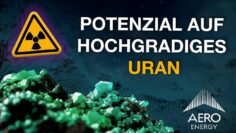{kanada_flagge} From everyday life, everyone knows that you only find what you know. This experience can be illustrated particularly well by the change in search criteria for uranium exploration in the Athabasca Basin in Saskatchewan over the past 70 years. It is well known Uranium grades in the Athabasca Basin are extremely high compared to the rest of the world. The two largest mines in the basin, Cigar Lake and MacArthur River, have uranium resources grading 18% and 17% U3O8, respectively.
These deposits were discovered at a time when the so-called “unconformity paradigm” was in effect, which states that uranium deposits form at the boundary between the crystalline basement rocks and the Athabasca Sandstone (see Figure 1; the English term is “unconformity”). According to this heuristic, quite several high-grade deposits have been found over the decades, mainly along the eastern margin of the Athabasca Basin. The disadvantage of this type of deposit is that mining usually involves extremely high costs because the surrounding sandstone is loose, porous, and thus permeable to water. This has led to catastrophic water intrusion, particularly at Cameco’s Cigar Lake mine, which is why the sandstone is now deep-frozen during mining.

Figure 1: The graphic is taken from Nexgen Energy’s recent presentation. It shows nicely, the “old” storage sites that have been found along the boundary.
Fission and Nexgen change the picture in the 2010s.
It wasn’t until the 2010s that the pure doctrine of “unconformity deposits” in the Athabasca changed. Responsible for this were the discoveries of Fission Uranium’s “Triple R” project and Nexgen’s “Arrow” project (see Figure 2). Their discoveries have made both companies stock market heavyweights. Fission Uranium (TSX: FCU) is currently trading at CAD 450 million, while Nexgen (TSX: NXE) has a market capitalization of CAD 2.2 billion. The deposits of both companies are located close to each other at the south-western edge of the basin. In addition, both deposits have in common that they are located directly in the bedrock in the form of almost vertical veins. Both projects do not extend directly to the surface and are designed as underground high-grade deposits. In the case of “Triple R”, there is also the fact that large parts of the planned mine lie below a lake (Patterson
Lake).
The discoveries by Fission and Nexgen triggered a staking rush around the entire Athabasca Basin in the early 2010s. A new paradigm had replaced the old: “Search the edges of the basin,” was the new slogan. However, the nuclear accident in Fukoshima subsequently made it extremely difficult for companies to finance themselves. On top of that, low-cost competition from Kazakhstan gained ever greater market share – most recently 40 percent. As is well known, uranium is extracted there by insitu leaching. The low uranium prices even forced Cameco to temporarily cease production at Cigar Lake because it was cheaper to buy on the uranium spot market. It is therefore not surprising that most uranium explorers in the basin have thrown in the towel. The recent recovery in the price of uranium has come too late for many – just at a moment when the issue of self-sufficiency in uranium supply is taking on a whole new geostrategic significance. The U.S. in particular needs to recognize its vulnerability to dependence on uranium imports.

Figure 2: The new Arrow (Nexgen) and Triple R (Fission) discoveries are located on the southwestern edge of the basin. At the time, the success of both companies triggered a staking rush around the Athabasca Basin.
Is the next paradigm shift for uranium exploration in the Athabasca Basin imminent?
This is where the Wollaston Domain comes into play, running completely outside the Athabasca Basin to the east. (See Figure 3) Fission Uranium itself has already successfully explored for uranium on the margin of this formation and has even defined a small resource (on Duddridge Lake, see Figure 3). However, when Fission became successful on “Triple R”, the company dropped the Wollaston Domain properties. Searchlight Resources (TSX: SCLT; FRA: 2CC2) gratefully picked up those licenses and generously added to them. Duddridge Lake was joined by Kulyk Lake. Searchlight now holds more than 300 km² of licenses in the Wollaston Domain, with CEO Stephen Wallace primarily targeting rare earths (on Kulyk Lake) and copper targets on Duddridge Lake.

Figure 3: The Wollaston Domain at the edge of the Athabasca Basin is marked in yellow. The green, or on the enlargement red marked areas are the licenses of Searchlight Resources.
“You only find what you know,” was the initial thesis. But there are, of course, chance finds. One such coincidence happened to Searchlight last year during an airborne measurement of data at the Kulyk Lake project. The instruments were actually supposed to measure thorium, which acts as a pathfinder for the mineral monazite, which in turn is known to be a prime host for rare earths. However, the surveys on Kulyk Lake last fall not only provided spectacular confirmation of a three-kilometer-long thorium zone north of Kulyk Lake (Figure 4), but then further south also showed completely unexpectedly high uranium readings over an area as large as two kilometers by 500 meters (see Figure 5). Only a few weeks ago, Searchlight was able to confirm these readings in the field. The initial walkover of both zones returned high to very high radioactivity on both targets. Full chemical evaluation of the samples is expected in a few weeks.

Figure 4: Searchlight discovered a three-to-five-kilometer zone of rare earth potential north of Kulyk Lake in 2021. Previously, only high-grade rare earth discoveries were known along the southern edge of the lake.

Figure 5: High-grade uranium over an area 500 meters by 2 kilometers. Aerial measurements were taken from 50 meters above the surface and in lines spaced 50 meters apart.
The 2022 Exploration Season is the Moment of Truth
The so-called “ground truthing” on Kulyk Lake was a complete success. On both the rare earth target to the north and the suspected uranium target further south, the instruments have measured high to very high radioactivity (up to 13,000 cps) in the rock in place. Both times, the rocks are pegmatites, i.e., the “exuded distillate” of the underlying magmatic granite body. The most important finding was that the radioactivity is present directly in the rock in place and can be traced there over a greater distance (150 by 50 meters). Most importantly, it could be ruled out that the radioactivity originated from rock fragments that were moved to their present location by glaciers.

Figure 6: Geologists have identified the uranium target to the south as a pegmatite ridge that protrudes from the surrounding landscape for a length of at least one kilometer – a so-called whaleback. To date, just one area, about 150 by 50 meters, has been surveyed and evidence of strong radioactivity has been found.
Are radioactive pegmatites the host rock for uranium and rare earths?
Pegmatites have recently become known to a wider public primarily in connection with major lithium discoveries. In particular, the kilometer-long Australian hard rock lithium projects are all pegmatites. The pegmatites at Kulyk Lake probably can’t come up with the element lithium. Instead, Searchlight geologists believe they may be an even rarer variety: radioactive pegmatites enriched in the elements uranium, thorium and potassium. The geologic sequence of three geologic processes is believed to have caused this particular enrichment outside the Athabasca Basin: Sedimentary processes were at the beginning, followed by magmatic processes, and finally metamorphic processes were at the end.
Sedimentary processes
Until about two billion years ago, the natural process of weathering bedrock and transporting it in river channels led to the formation of naturally enriched deposits of resistant minerals, including gold, the rare-earth mineral monazite, and even uranium. But about two billion years ago, bacterial life evolved, changing Earth’s atmosphere and adding oxygen. At that point, a major rusting event occurred as many elements reacted with oxygen. The uranium at the Earth’s surface was dissolved and poured into the ancient sedimentary rocks of the Wollaston domain, which are therefore naturally enriched in uranium, as are the monazite gravels.
Magmatic Processes
When huge amounts of liquid granitic magma penetrate the Earth’s crust and cool very slowly, common rock-forming minerals rich in iron and magnesium crystallize out first. As the magma cools, more and more common mining minerals crystallize out. At the end of the process, when 99% of the rock has crystallized out, a residual fluid remains that is highly enriched in rare earths and uranium. This residual fluid forms veins called pegmatites. This is the second process that has occurred at Kulyk Lake.
Metamorphic processes
The pegmatite veins formed deep in the Earth’s crust, and the surrounding rock was so hot that some of it also melted. The pegmatites “swallowed” these metamorphic fluids, which added even more high-grade uranium and rare earths to the veins. The pegmatite veins would thus be the distilled essence of sedimentary, igneous, and metamorphic concentration.
Searchlight’s Whiskey Hypothesis for Kulyk Lake
Alf Stewart, Chairman of Searchlight, compares the pegmatites on Kulyk Lake to a “triple-distilled Irish whiskey” – undoubtedly a valuable substance, well-aged at that.
The question for investors now is: What are the odds that Searchlight can substantiate its “whiskey hypothesis” and what happens if it does? If chemical analysis of the pegmatite samples collected does indeed confirm high uranium values at surface, this could herald the next paradigm shift for uranium exploration in the Athabasca Basin. Little exploration has been done this far outside the basin. After all, the newly discovered pegmatite swarms on Kulyk Lake can now be traced over a distance of 10 kilometers from north to south. This discovery by Searchlight is brand new and it is a new deposit type. The advantages of a pegmatite-bound uranium discovery at surface would be obvious.
Exploration alone would be cheaper and faster than expensive deep drilling. So-called channel samples (“channel samples”) with the rock saw will therefore probably play an important role in low-cost exploration in the first step. The advantages in exploration would apply even more to subsequent mining. An open pit uranium mine would be the biggest innovation in the Athabasca Basin since exploration for uranium began there 70 years ago. As a point of reference and to classify upcoming news from Searchlight, it is worth noting the following: The famous Langer Heinrich project in Namibia has measured resources of 71.87 mmlb U3O8 (66.2 million tonnes at an average grade of 0.049% U3O8) and indicated resources of 17.96 mmlb U3O8 (18.8 million tonnes at an average grade of 0.044% U3O8). The Ranger 3 Deeps zone in Australia has underground uranium resources grading 0.274% U3O8.
Conclusion Although there is a strong case for Searchlight’s whiskey hypothesis in relation to the Kulyk Lake pegmatites, the company is still in the early stages of many things. No doubt the reported high radioactivity is promising. But it won’t be until the chemical analyses are available in a few weeks that we will know how high the uranium or even the rare earth contents are in the pegmatite samples. That will be the whisky sample.
It is after positive results that the real work on Kulyk Lake would really begin. Searchlight would have to multiply its activities and answer many new questions that would arise: How continuous are the grades? Does the mineralization continue to depth, and where along the 10-kilometer structure might the sweet spot of mineralization lie?
At least Searchlight would no longer have to worry about its future financing after a discovery. At least since Fission and Nexgen, uranium investors have known the value of a new paradigm in uranium exploration in the Athabasca Basin. The rewards of success can be extremely high. We’ll keep our fingers crossed for Searchlight in the coming weeks and hope for a good vintage whiskey on Kulyk Lake.
Jetzt den Goldinvest-Newsletter abonnieren!
Goldinvest auf LinkedIn
Risikohinweis: Die GOLDINVEST Consulting GmbH bietet Redakteuren, Agenturen und Unternehmen die Möglichkeit, Kommentare, Analysen und Nachrichten auf http://www.goldinvest.de zu veröffentlichen. Diese Inhalte dienen ausschließlich der Information der Leser und stellen keine wie immer geartete Handlungsaufforderung dar, weder explizit noch implizit sind sie als Zusicherung etwaiger Kursentwicklungen zu verstehen. Des Weiteren ersetzten sie in keinster Weise eine individuelle fachkundige Anlageberatung und stellen weder ein Verkaufsangebot für die behandelte(n) Aktie(n) noch eine Aufforderung zum Kauf oder Verkauf von Wertpapieren dar. Es handelt sich hier ausdrücklich nicht um eine Finanzanalyse, sondern ausdrücklich um werbliche / journalistische Texte. Leser, die aufgrund der hier angebotenen Informationen Anlageentscheidungen treffen bzw. Transaktionen durchführen, handeln vollständig auf eigene Gefahr. Es kommt keine vertragliche Beziehung zwischen der der GOLDINVEST Consulting GmbH und ihren Lesern oder den Nutzern ihrer Angebote zustande, da unsere Informationen sich nur auf das Unternehmen beziehen, nicht aber auf die Anlageentscheidung des Lesers. Der Erwerb von Wertpapieren birgt hohe Risiken, die bis zum Totalverlust des eingesetzten Kapitals führen können. Die von der GOLDINVEST Consulting GmbH und ihre Autoren veröffentlichten Informationen beruhen auf sorgfältiger Recherche, dennoch wird jedwede Haftung für Vermögensschäden oder die inhaltliche Garantie für Aktualität, Richtigkeit, Angemessenheit und Vollständigkeit der hier angebotenen Artikel ausdrücklich ausgeschlossen. Bitte beachten Sie auch unsere Nutzungshinweise.
Gemäß §34b WpHG und gemäß Paragraph 48f Absatz 5 BörseG (Österreich) möchten wir darauf hinweisen, dass die GOLDINVEST Consulting GmbH, Partner, Autoren, Auftraggeber oder Mitarbeiter der GOLDINVEST Consulting GmbH Aktien der Searchlight Resources halten und somit ein Interessenskonflikt besteht. Die GOLDINVEST Consulting GmbH behält sich zudem vor, jederzeit Aktien des Unternehmens kaufen oder verkaufen zu können. Dies kann unter Umständen den jeweiligen Aktienkurs des Unternehmens beeinflussen.
Die GOLDINVEST Consulting GmbH hat aktuell eine entgeltliche Auftragsbeziehung mit dem Unternehmen über welches im Rahmen des Internetangebots der GOLDINVEST Consulting GmbH sowie in den sozialen Medien, auf Partnerseiten oder in Emailaussendungen berichtet wird. Die vorstehenden Hinweise zu vorliegenden Interessenkonflikten gelten für alle Arten und Formen der Veröffentlichung, die die GOLDINVEST Consulting GmbH für Veröffentlichungen zu Searchlight Resources nutzt. Wir können außerdem nicht ausschließen, dass andere Börsenbriefe, Medien oder Research-Firmen die von uns empfohlenen Werte im gleichen Zeitraum besprechen. Daher kann es in diesem Zeitraum zur symmetrischen Informations- und Meinungsgenerierung kommen. Für die Richtigkeit der in der Publikation genannten Kurse kann keine Garantie übernommen werden.













